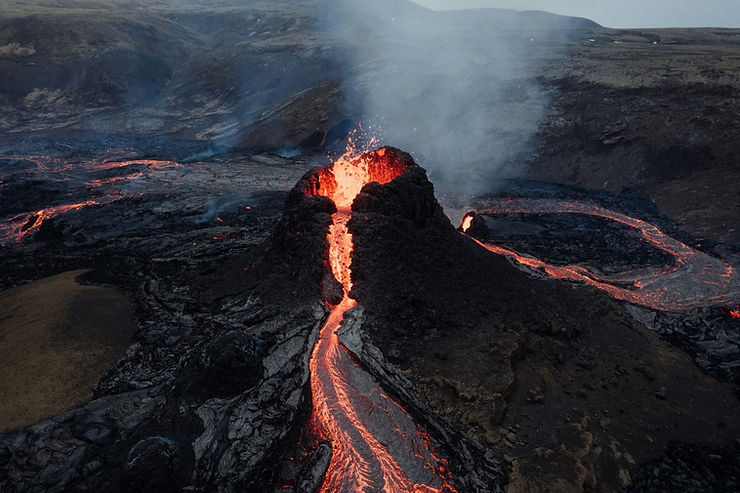By: Andrew Lu
Last year, the volcano Fagradalsfjall – located in Iceland – erupted after 781 years of dormancy! And what did ambitious researchers and courageous tourists do? They crept closer to the vicious flames and took pictures of red magma flowing from the pitch-black mounds.
But photo documentation can only go so far. What scientists want to see is miles below – where the light cannot reach. Even to this day, scientists still can’t describe the flowing melton rocks below volcanoes. So brave researchers climbed the skies with a helicopter to scoop lava on the first day of the eruption. The magma samples were sent to multiple labs, and they all reported the same astonishing thing: the lava contained a high concentration of crystals.
With the help of recent volcanic lab reports, scientists have been digging deep and closer to the Earth’s mantle. In a paper published (June 2022) in the journal Nature Communications, researchers observed the data collected by labs and summarized that the sampled magma consists of a wide variety of materials found in the mantle *.
“We have a detailed record of the different types of composition that we can find in the mantle now, and it must be very heterogeneous, very variable,” said Frances Deegan, a volcanologist at Uppsala University in Sweden. He was a co-author of the paper.
After studying the chemical composition, scientists are sure that the lava from Fagradalsfjall is from a deep underground magma chamber – far below Earth’s crust. Researchers like Ed Marshall, a geochemist at the University of Iceland, raced to collect more samples after the eruption. “We were working all hours. You’re asleep, and the volcano’s still erupting, and you’re like, ‘I got to get back out there,’ said Dr. Marshall. “But it’s hard to describe how rare this kind of thing is.”
Why is the magma from this specific volcano rarer than others? Fagradalsfjall sits in a rare location – directly above the fault line between the Eurasian and North American plates. The plates have been pulling and rubbing against each other. Volcanic activity here happens every millennium or so.
The recent eruption was preceded by a year of minor earthquakes near Fagradalfjall. Olafur Flovenz, director at Iceland GeoSurvey, suggests this in a paper recently published with multiple co-authors: The magma didn’t accumulate in the crust but was caused by carbon dioxide from magma between the mantle and the crust. This region is called Mohorovicic discontinuity (or Moho).
Most volcano eruptions occur when small flows of lava mix together, forming one huge pool of magma. “This mixing process is an essential geologic process, but it’s never been directly observed,” said Dr. Marshall. But this pool of magma is way too deep for scientific research nowadays. And when magma rises to the crust, most of the important chemicals are lost.
Thankfully, when Fagradalfjall erupted, the magma was directly from the mantle. All the important chemicals were inside the sampled magma. “For the first time, more or less, we are looking at an active eruption on our oceanic crust where the lava is directly erupting from the mantle source,” Dr. Flovenz said.
Thankfully, the lava vents were easy to access, and the eruption wasn’t too big for it to be “untamable.”
When Dr. Deegan and her co-author, Ilya Bindeman, at the University of Oregon examined the samples, they were amazed when they found a wide variety of chemicals. They concluded that the magma was mixed from different parts of the mantle. They also found the oxygen isotopes were nearly identical in the samples.
Researchers have found a high concentration of oxygen-18 in Iceland. Before the eruption, Iceland was known to have “mysteriously low levels of oxygen-18,” and the chemical is supposed to be found commonly in volcanic rock. Dr. Bindeman said there has been a scientific debate for decades, drawing the conclusion that Iceland might not contain many oxygen isotopes in the mantle. But now, “We found that the depletion happens somewhere else,” he said.
“These are very exciting times. I had never had the hope that I would live to see this unrest and eruptions on this peninsula. This has been extremely interesting for the geosciences community,” said Dr. Flovenz. He’s been studying Iceland’s volcanoes since 1973.
“It’s an absolutely amazing eruption for our field,” said Dr. Marshall, “and it’s one of those things that will be studied for a long time.”
The Fagradalfjall eruption in 2021 was truly a miracle. Scientists and researchers were (and still are) scrambling to analyze the lava samples. The eruption unlocks a crucial understanding of Earth’s mantle – a place scientists haven’t gotten a chance to research until now.
*Paper mentioned briefly in the article: Bindeman, I.N., Deegan, F.M., Troll, V.R. et al. Diverse mantle components with invariant oxygen isotopes in the 2021 Fagradalsfjall eruption, Iceland. Nat Commun 13, 3737 (2022).
Link: https://doi.org/10.1038/s41467-022-31348-7











